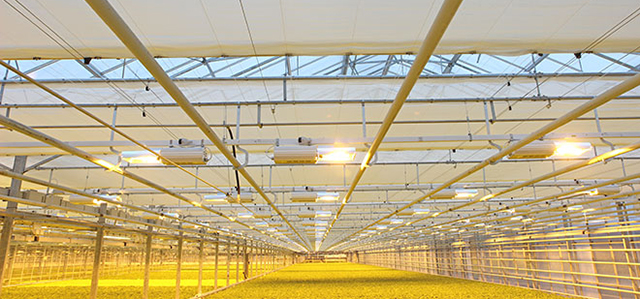Considering that our planet has supported a variety of plant species for nearly 4 billion years, it would be reasonable to assume that the plant/sun relationship is both a dynamic and an intimate one. When considering what it takes to provide our greenhouse and indoor plants with the best in artificial lighting, it’s prudent to consider precisely what aspects of this relationship have led to successful outdoor crop production.

Humans have a condition that, at times, may preclude us from understanding the complex interplay of highly evolved plant systems. This condition, anthropocentrism, refers to humans who tend to regard themselves to be at the center of the universe. This can lead to close mindedness and an inability to grasp the ‘big picture’. Combining a pinch of anthropocentrism with ‘this is the way we’ve always done it’ mentality can seriously get in the way of design and development of artificial lighting systems for our indoor gardens. Agricultural lighting engineers can reduce the importance of the natural symbiosis that occurs between broad spectrum sunlight and plants by attempting to force development with specific narrow band wavelengths that research has shown proves beneficial during specific stages of growth.
That research has led to a widely accepted market driven approach to artificial plant lighting that has historically been one whereby plants respond favorably to red light during their bloom phase and show preference to blue light during their vegetative phase. This is now accepted doctrine and has taken on the look of law, however these conclusions were obtained from laboratory trials in which the chlorophyll response was measured against a wide spectrum of light frequencies and those with the highest response were considered photosynthetically active and the rest considered unimportant. This approach, while good for selling a wide variety of lamp types, neglects to take into consideration the big picture approach to lamp design that would intuitively suggest that plants exposed to broad spectrum wavelengths are more likely to respond similarly to plants that had been grown under broad spectrum sunlight conditions.
Armed with this knowledge and driven by rising utility rates, engineers have been on a quest to develop lamp technologies that deliver intensities and PAR spectrums which are energy efficient, long life/low depreciation, stable spectrum and afford low thermal contribution while optimizing crop production values. That pursuit has led to designing lamps that reduced, or in some cases eliminating what was considered “wasted” wavelengths while those wavelengths associated with the greatest response are emphasized.
Many of the LED panels have lamps that are either all RED diodes, all BLUE diodes, or a hybrid matrix of the two while not including what are the ‘less important’ wavelengths. This approach to indoor lamp technology tends to monitor the plants photosynthetic response and any increase in said response is considered a victory.
When considering which artificial light to install in an indoor garden, keep in mind that the light you choose affects every aspect of your system: water temperature, air temperature, evapotranspiration rates, RH, VPD, rate of CO2 uptake, DO levels, symbiotic bacterial densities, disease resistance, pest resistance, canopy biomass, root biomass, fruit and flower production, nutrient density, brix levels, the list is virtually endless. In sunlight conditions, where the plants receive broad spectrums throughout the entire growth cycle, successful plant development is achieved through the processes of natural equilibrium whereby all these elements come together to benefit overall plant health.
Manmade lamps cannot cost effectively recreate the sun in terms of power consumption and broad spectrums such that indoor gardening would be economically feasible with such a lamp so sacrifices must be made. When considering those sacrifices the objective would be to reduce those spectrums that are less likely to have the least negative impact on plant development, but not eliminate those spectrums from a lamp that emits broad PAR spectrums similar to what plants would be exposed to under natural sunlight conditions.
A narrow spectrum approach to artificial plant lighting design ultimately begs the question; if there are nearly 400,000 different plant species on this planet, from greatly varied regions: Why would one attempt to apply a generalized model to such a disparate population? In designing and promoting stage specific lamp solutions we have essentially divorced ourselves from the natural cycle and consequently blinded our ability to see the elegant solution that nature has proposed. For us to grow plants that are healthy, nutrient dense and prolific we must approach artificial lamp design starting with an understanding of natural conditions first.
The best light to grow plants is the sun. It always has been and always will be. The reason is 4 billion years of symbiotic evolution. Greenhouse gardeners take advantage of that evolution in that their crops do rely on sunlight as the primary light source. When regions and time of year require supplemental lighting systems to be used to augment insufficient levels of sunlight for a particular crop, the greenhouse gardener will also be interested in finding the latest technologies that meld energy efficiencies, crop repeatability, reduced time to harvest, tighter internodal spacing, increased fruit and flower sizes, and higher quality for their crops.
High Intensity Discharge or HID lighting systems have been in use as artificial lighting systems in both greenhouse and indoor gardens for the last 50 years. What separates the greenhouse grower from the indoor grower is that they will rely on sunlight for the primary light source and the supplemental lighting system they select should deliver the spectrums the crops require, and not waste precious energy by being on or running at higher intensities when natural light conditions preclude the need for the supplemental lighting to be running.
Ultimately it is through lighting and control systems that do offer wider control capabilities which will enable the greenhouse gardener to meet their crops daily light integrals without using energy unnecessarily by doing so. As an industry we must try harder to advance those technologies that reduce waste and outperform prior generation technologies. The goal with future lamp designs is to have an eye on mimicking nature, to the extent that we can, by providing long life, low wattage, recyclable with broad and stable spectrums that take our plants from propagation through final flower, from one generation to the next.
Darryl Cotton is President of Inda-Gro Induction Lighting Systems.
Related Articles & Free Email Newsletter Sign Up
How Light Movers Can Maximize Light in an Offseason Greenhouse
How to Optimize Light Intensity in an Indoor Garden




Comment here